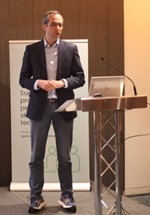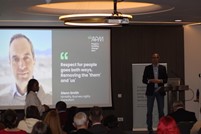How to build team collaboration and become a project leader everyone loves

Glenn Smith is one of the world’s leading business agility experts, a Scaled Agile (SAFe) Consultant Trainer (SPCT) with over 20 years’ experience of leading and guiding leaders of complex and highly technical change in a wide range of industries. His company, Nimbility, works with a diverse range of clients to deliver successful transformational change.
 In early March, we were lucky to hear from Glenn at the joint APM People and Enabling Change SIG Conference, Fearless Change. Glenn delivered an informative and entertaining presentation, on ’Respect for people goes both ways, removing them and us’ to highlight opportunities and activities to build collaboration between those leading the change and those delivering or experiencing it.
In early March, we were lucky to hear from Glenn at the joint APM People and Enabling Change SIG Conference, Fearless Change. Glenn delivered an informative and entertaining presentation, on ’Respect for people goes both ways, removing them and us’ to highlight opportunities and activities to build collaboration between those leading the change and those delivering or experiencing it.
Glenn shared his own experience of being asked to change the ways of working of 450 people across the globe and how that learning had shaped his thinking.
The statistics are stark, 70% of change initiatives fail to deliver the intended outcomes. Research tells us people fear loss more than they value potential gains. This creates resistance to change and that resistance is reflected in their behaviours, varying from ‘foot-dragging’, withdrawal, ‘working to rule’ and even sabotaging the change.
This happens when there is a lack of alignment and respect between leaders and teams. Misalignment happens when we don’t understand each other’s worlds. Respect is lost, because neither side has taken the time to find out about the other.
Glenn told us that in Toyota’s museum there is a poster with a quote from the early days of the Toyota production system (the forerunner to lean and agile). It refers to the importance of an attitude or mindset as mindsets drive behaviours, and the need for mutual understanding and respect. Respect is key between teams and managers; it’s something to value and doesn’t mean obey. Leaders need to understand and respect teams, teams need to understand and respect leaders.
It’s not as simple as ‘walking in someone else’s shoes’, which is often described as a way to understand someone’s perspective. It takes a lot of energy and we must remember that even when ‘in their shoes’ we’re still looking at their world through our own lens of our experiences and values.
As leaders, we may have also forgotten what it’s like to be on the ‘shop floor’ and team members may have little knowledge or experience of the highest level of strategic or financials issues that are driving management thinking. This will inevitably create friction and cause a lack of trust not just between leaders and teams, but across teams. So what can we do?
Here are some thought-provoking suggestions for solutions that Glenn shared:
Building respect. This isn’t just about being nice. We must provide a psychologically safe space where we can all challenge ourselves to be better. Glenn also reminded us psychological safety is not the absence of conflict but using conflict in a way where we “gang up on the problem, not each other!”
Sharing ‘why’. Glenn advised that communicating a compelling reason for change, possibly with a generative image, is essential to inspire people, unlock creativity and align them to achieve the goals.
Appropriate language. Glenn built on some of the elements raised by earlier speakers when he explained a key element to building respect, is to change the conversations that happen in the organisation. He suggested we needed more responses that started with ‘yes and’ rather than ‘yes but’ or ‘why?’
Positive narratives. We should consider our own internal conversations in relation to experiencing poor behaviours by other drivers. Depending on the narrative we create about the other persons intent we can vastly impact our response.
Avoiding miscommunications. You can see for yourself, in this video It’s not about the nail that Glenn shared. It’s a short, but informative, video that demonstrates miscommunications and misunderstandings in a humorous way.
When looking for long-term solutions Glenn suggested using a dialogic organisation development approach. This involves getting people to have conversations and changing those conversations with new language, because it changes the reality of the organisation and therefore the behaviours.
Glenn cautioned this was not the fastest or cheapest way, but it will achieve the longest lasting and most impactful change.
Identify strengths
We completed a short exercise to experience ‘appreciative inquiry’ – a technique to identify strengths in the way things are already working instead of simply looking for problems to be solve. There are five generic processes.
- Choosing the positive as the focus of enquiry
- Inquire into exceptionally positive moments
- When where you most connected to the organisation?
- When were you most proud of working here?
- Create shared images of a positive future

Glenn summed up the workshop by encouraging us to innovate and improvise ways to create the desired future. of course, there’s no magic way to remove the resistance, but we can make life easier.
Glenn’s top takeaways for removing the them and us
- Create a safe space for conversations to happen
- Bring everyone along with the journey
- Bridge the empathy gap
- Build a guiding collation
- Create a generative image
- Involve people through appreciative inquiry
Read the conference overview and view other presentation reviews.


0 comments
Log in to post a comment, or create an account if you don't have one already.